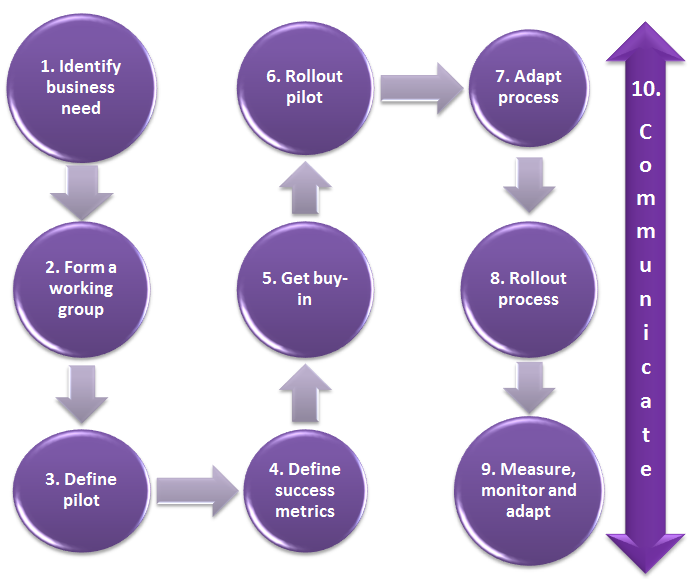10 Step Recipe for Implementing Process Change
“Change is the only constant in life.” – Heraclitus, the Greek philosopher
Yet people resist change. It is very important to think through before implementing a change particularly if it impacts bigger teams. Recently, I had to implement an internal process change which had wide impact. It is one thing to run large scale programs and another to implement change. It was one of the toughest things I had to do in my career and I learned a lot. I would recommend treating process implementation as a type of product (Lesson 5 in my blog – Lessons Learnt Implementing Process Change) and define some of the same artifacts like vision, process backlog, minimum viable process etc. Here is a 10 step recipe for implementing an internal process change, based on my learnings.

1. Identify the business need
- Determine the business problem you are trying to solve. Identify how it is impacting team productivity or customer/partner happiness.
- Create a short survey to measure satisfaction on the existing process (or lack thereof) and send it out to the impacted partners/customers to make sure that it is indeed a problem that they are facing. Here is a good guide to measure customer satisfaction. Apart from including questions related to satisfaction, include one free text question in the survey asking for their top 3 suggestions.
- Talk to a few of the customers/partners regarding the problem and the business need.
- Create a solid business case and get buy-in from Senior Management that you have their support in fixing the problem.
2. Form a working group
Build a working group with motivated team members who believe in fixing the problem. Recommend a team size of 4 to 5 for a core working group. Form an extended working group with representatives from each of the team that is going to be impacted by this change. Core working group should come up with the proposed process and get buy-in from the extended working group. Extended group’s responsibility is to communicate the process changes to their teams.
3. Define a pilot
Pick a few teams that you want to rollout the process to. This will help figure out the issues and fix them before implementing across the wider organization. Work with the pilot teams to agree on the process.
4. Define success metrics
Define how you are going to measure the success of the process change. Think through some metrics (may be improvement in customer satisfaction score, etc.). Without having defined metrics, it is going to be hard to measure the efficacy of the process change.
5. Get buy-in
Get buy-in from the extended working group and the impacted teams about the pilot. People usually are not supportive of process they do not create. Having a representative from each of the teams in the extended working group will help tremendously in getting the required buy-in.
6. Rollout pilot
Communicate widely before rolling out the pilot. Document a list of frequently asked questions (FAQs). Create training material if needed. Rollout the pilot process.
7. Adapt process based on pilot
Talk to the pilot teams and understand what worked and what didn’t. Make changes to the process based on the feedback. Ensure that the process scales when you expand it to more teams.
8. Rollout process
Similar to rolling out the pilot, communicate widely before rolling out the process. Ensure all the FAQs and training material created during pilot are updated to reflect the changes with the full rollout. Make sure to run it by a couple of customers/partners and incorporate their feedback. Anticipate issues and create necessary backup plans.
9. Measure, monitor and adapt
- Once you rollout the process, create multiple channels for the stakeholders to provide feedback. Create a slack channel, gsheet and/or email alias for feedback.
- Measure the success metrics. Continue to measure customer satisfaction by sending surveys at a regular cadence (may be once a quarter or once in six months).
- Monitor the process to ensure it is fixing the business problem as intended.
- Adapt the process as needed. Make sure to let the process bake before you start making changes. Don’t make too many changes too often.
10. Communicate
Communicate throughout the process implementation. Use various channels of communication – emails, roadshows, presenting at staff meetings, question and answer sessions etc. Err on the side of over communicating than under communicating. Create a distribution list that is open to anyone from the impacted teams interested in knowing the updates and provide them regular status updates.
Lastly, as with any project implementation, celebrate success after process implementation. Good luck!